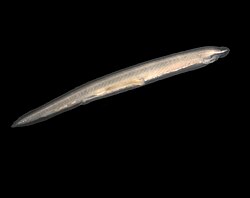Eumetazoa
| Eumetazoans Temporal range: Ediacaran - Present, 635–0 Ma |
|
|---|---|
 |
|
| A lancelet | |
| Scientific classification | |
| Kingdom: | Animalia |
| Subkingdom: |
Eumetazoa Buetschli, 1910 |
| Phyla | |
|
Radiata (unranked) Bilateria (unranked)
|
|
Radiata (unranked)
Bilateria (unranked)
Eumetazoa (Greek: εὖ [eu], well + μετά [metá], after + ζῷον [zóon], animal) is a clade comprising all major animal groups except sponges, placozoa, and several other obscure or extinct life forms, such as Dickinsonia. Characteristics of eumetazoans include true tissues organized into germ layers, the presence of neurons, and an embryo that goes through a gastrula stage. The clade is usually held to contain at least Ctenophora, Cnidaria, and Bilateria. Whether mesozoans belong is in dispute. Ctenophora now appear basal eumetazoa, and placozoa also appear to have emerged in eumetazoa. Eumetazoa would then be a basal Metazoan clade as sister of Porifera.
Some phylogenists have speculated the sponges and eumetazoans evolved separately from single-celled organisms, which would mean that the animal kingdom does not form a clade (a complete grouping of all organisms descended from a common ancestor). However, genetic studies and some morphological characteristics, like the common presence of choanocytes, support a common origin.
Eumetazoans are a major group of animals in the Five Kingdoms classification of Lynn Margulis and K. V. Schwartz, comprising the Radiata and Bilateria — all animals except the sponges, placozoans and mesozoans. When treated as a formal taxon Eumetazoa is typically ranked as a subkingdom. The name Metazoa has also been used to refer to this group, but more often refers to the Animalia as a whole. Many classification schemes do not include a subkingdom Eumetazoa.
...
Wikipedia
